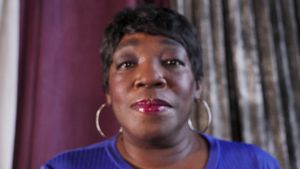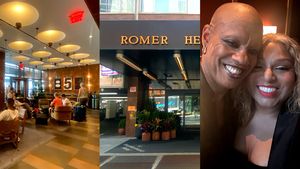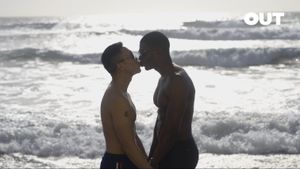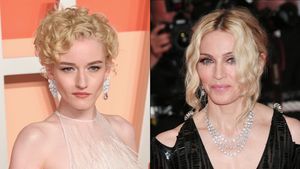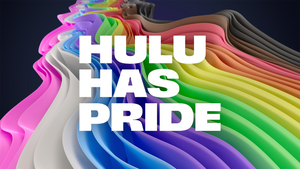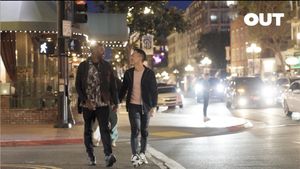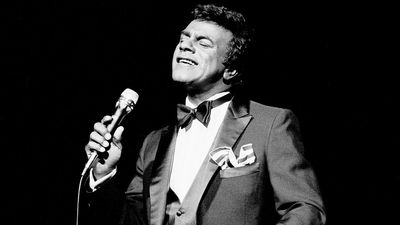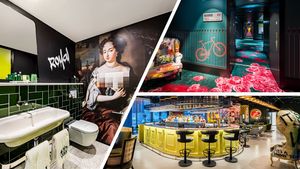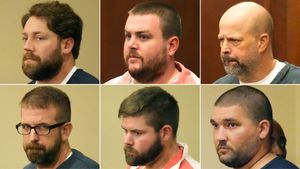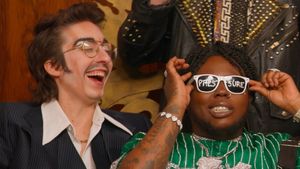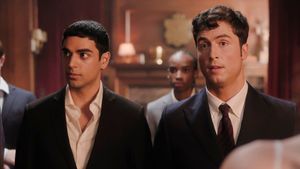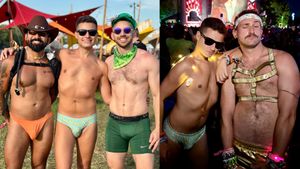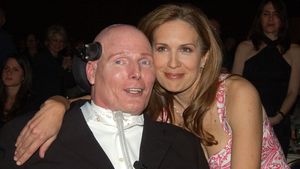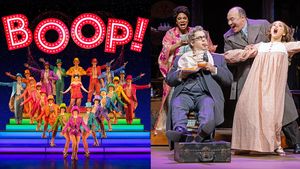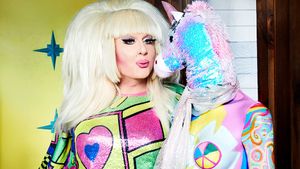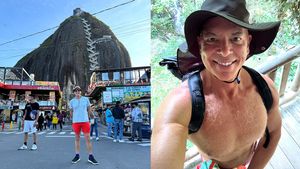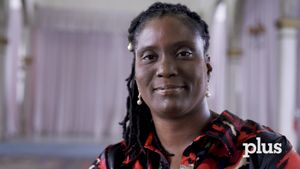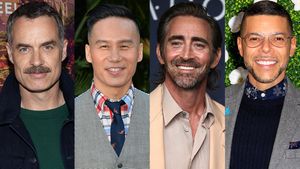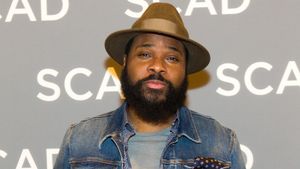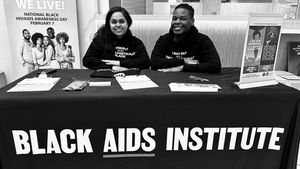CONTACTAbout UsCAREER OPPORTUNITIESADVERTISE WITH USPRIVACY POLICYPRIVACY PREFERENCESTERMS OF USELEGAL NOTICE
© 2025 Equal Entertainment LLC.
All Rights reserved
All Rights reserved
By continuing to use our site, you agree to our Privacy Policy and Terms of Use.
We need your help
Your support makes The Advocate's original LGBTQ+ reporting possible. Become a member today to help us continue this work.
Your support makes The Advocate's original LGBTQ+ reporting possible. Become a member today to help us continue this work.
The cult following of James Dean is one of the most unusual and enduring in the annals of film. When the 24-year-old actor died in a car accident in Cholame, Calif., on September 30, 1955, only one of his three major films, East of Eden, had been released. Dean had been famous in life for less than six months. With the posthumous release of his next two films (Rebel Without a Cause, a month after his death, and Giant, the following year) Dean's impact on post-World War II young people was so powerful that fan worship reached near-epidemic proportions. Movie magazines and gossip columnists clamored for intimate details of his personal life, while fans lined up to pay to see the wrecked Porsche Spyder in which he died. In the five decades since, hundreds of books have been written about the actor and numerous film biographies and documentaries produced, all purporting to tell the true story behind the legend. While Dean's popularity endures, to many he remains as inscrutable as ever. Each year thousands of fans from around the globe make a pilgrimage to Fairmount, Ind., Dean's hometown, to look for answers, pay homage to their idol, visit his grave site, and see the massive collection of memorabilia in the James Dean Gallery. Owned by David Loehr, the gallery houses thousands of artifacts associated with the actor. Loehr speaks with The Advocate about his own fascination with the late star, Dean's sexuality, and what the actor might have accomplished if he'd lived.
The Advocate: Why do you think James Dean continues to hold such appeal for gay audiences?
David Loehr: I think a lot of it was his sensitivity, which he was able to portray on-screen. Before him most actors were tough and weren't able to show their soft side. Dean would cry and show emotions and feelings and vulnerability. And, of course, a lot of it is his looks. He was just incredible-looking. The facial expressions and the little things he'd do with his eyebrows and his eyes were just stunning. But I have to say, our gallery has been open for 23 years, and he's really very appealing to everybody. Older guys say that he was their hero in high school, and younger guys say they want to be like him, and straight women just love him and want to cuddle him. But we get a lot of gay men, and, surprisingly, a lot of lesbians come to the gallery. I think his appeal is broad. Everyone can enjoy his personality and talent and looks and whatever he had to offer. He's still influencing people.
How did you discover Dean?
In 1974 a friend gave me a biography, James Dean: The Mutant King by David Dalton, for Christmas. I was traveling from Massachusetts to California on a bus, and I read the entire book on the way there. I didn't know anything about him, really, just the name and the face. The book was so good that I was intrigued by his life. When I got to California I saw East of Eden on the big screen for the first time and I was knocked out by his performance. That was it. I was hooked.
How did you begin your collection?
I got another book about him and a poster and a button and didn't realize it would turn into my life. I started collecting and getting more involved with him. When I moved back to New York I worked with David Dalton on another book, James Dean: American Icon. That was my first big Dean project. Since then I've worked on most of the books and documentaries.
How did you come to visit Fairmount for the first time?
I was moving from Pasadena back to New York and had a van and went out of my way to stop here. When I got here it was Mother's Day, 1979. I spent the afternoon in the town, and it was just so old-fashioned. I walked around the town and went to his grave site and out to the farm and then headed to New York. My mind was spinning the whole way there thinking of different things that could be done.
How sensitive is the subject of Dean's sexuality to his family and straight fans?
In Fairmount they don't talk about it or discuss it, really. People who knew him say he had girlfriends all through high school, and he did. In his book James Dean: The Biography, Val Holley researched that thoroughly for many years and uncovered some male lovers that Dean had, mostly in New York and Hollywood. It goes with his personality. He was so experimental in his life and wanted to learn about everything. He'd get into a subject and work on it until he mastered it and then move on to the next thing. I think it's fairly well known that he had some gay relationships, but he had girlfriends all through his life too. I don't know if you can pinpoint him as gay or bisexual. He was just a total free spirit.Every few years a new biography of Dean is published. How are writers still unearthing new information about a man who died 55 years ago at 24?
It's amazing, really. New photos keep turning up too. We're always discovering new photos of him. There were several books that came out in 2005 and they all had different angles, such as The Making of Rebel Without a Cause. The best one was James Dean by George Perry that I worked on with Dean's family. Perry uncovered new information too. I guess it's just the author's job. There have been a lot of books that were based on hearsay, and often writers will read other books and rehash their own versions. But some, like Val Holley, will do their own research and delve into it and get new information.
What in your opinion is the definitive biography of him?
There are three I recommend: James Dean: The Mutant King by David Dalton, which was published in 1974. Most of the serious Dean fans still consider it the best. There are a few inaccuracies in it, but nothing too serious. The Val Holley book is just terrific. It's probably the most accurate, but it doesn't deal with the movies at all. It covers his childhood and college years and early years in New York doing television and Broadway. It pretty much ends when he starts his movie career. And James Dean: A Short Life by Venable Herndon, which also came out in 1974. It was good. He uncovered and interviewed a lot of people close to Dean for the first time. Also, the book by George Perry, which was authorized by Dean's family. It's pretty accurate.
You mentioned that you're still finding undiscovered photos of Dean. How is it possible that there are so many photographs of a man who was famous for just a few months while he was alive?
[Laughs] Well, the camera loved him. It's strange, but it's almost like he was planning his destiny or his legend. He always had photographers with him. There were six major photographers he hung out with and who followed him around. There were an awful lot of childhood photos too. I think he gravitated toward the camera. If he saw someone with a camera, he'd make sure he got in the middle of the picture.
Who was the most instrumental gay person in Dean's life?
Probably Rogers Brackett [a well-connected radio director], who got him started and gave him a lot of help in California in the early days. He gave him some financial assistance and made a lot of early Hollywood connections for him.
If Dean hadn't died so young, what kind of career do you think he would have had?
Based on looking at a lot of his screen tests and rare footage of him, I think he would have made some comedies because he was very comical. He wanted to do Shakespeare. He was working on a Jekyll and Hyde screenplay at the time of his death that was more about a psychological transformation than physical. He wanted to be behind the camera. I think he would have been like Clint Eastwood and Paul Newman, who were pretty much his contemporaries. They went on to direct and star in films and do great acting jobs, and in Newman's case had a career as a race car driver. He would have aged gracefully and went on to give us a much bigger body of work.
The annual James Dean Festival is this weekend. How many people come to Fairmount for it each year?
We get 20,000 to 30,000 people. There are 3,000 custom cars and a parade and a look-alike contest and a '50s dance contest. It's great. It's a real boost for the local economy.
Do a lot of celebrity fans come to Fairmount to pay homage to Dean?
Rufus Wainwright has been here a few times. We became friends, and he came and did a benefit performance for the Fairmount High School restoration project. Morrissey filmed a video [1988's "Suedehead" -- see below] here. Bob Dylan came through late one night. Jamie Bell, Jeremy Davies, Meat Loaf and his band have all stopped by. It's interesting. It's a small Indiana town, but it has an international flair to it. Besides celebrities, we get people from all over the world.
You and your partner, Lenny, are a gay couple who live in Fairmount, which is a fairly small town, and there are a lot of gay fans of Dean's who visit throughout the year. What's the attitude toward gay people there?
They're surprisingly very understanding. Perhaps it's because there are a lot of Quakers here, and Quakers are very tolerant and understanding of others. Lenny and I started this thing in 1980, and we got our first apartment here in 1985 or and then opened the gallery in 1988. So we've been here for 25 years. There's been the occasional incident where someone drives by and yells names, but it doesn't happen very often. It's pretty amazing. The town is great, and I think we're pretty well accepted. We live in one of the most prominent houses here, a huge Victorian right in the middle of Main Street. We don't walk down the street holding hands or waving flags, but we're very visible. I think we're very accepted. Just by being here 25 years and living our lives honestly, we've made an impression on people, and they see that we're not so bad.
The 35th annual James Dean Festival takes place in Fairmount, Ind., September 25-27. For more information on the James Dean Gallery, click here.
Watch Morrissey's video for "Suedehead," filmed in Fairmount, below.
Recommended Stories for You
From our Sponsors
Most Popular
More Videos
0 seconds of 1 minute, 39 secondsVolume 0%
Press shift question mark to access a list of keyboard shortcuts
Keyboard Shortcuts
Shortcuts Open/Close/ or ?
Play/PauseSPACE
Increase Volume↑
Decrease Volume↓
Seek Forward→
Seek Backward←
Captions On/Offc
Fullscreen/Exit Fullscreenf
Mute/Unmutem
Decrease Caption Size-
Increase Caption Size+ or =
Seek %0-9
Copied
Live
00:00
01:39
01:39
Watch Now: Pride Today
Latest Stories
Eight men have accused Christian rock star Michael Tait of sexual assault
July 29 2025 3:01 PM
14 LGBTQ+ disability activists who are changing the world one fight at a time
July 29 2025 12:56 PM
Lawsuit challenges EEOC's failure to investigate anti-transgender discrimination
July 29 2025 6:59 PM
Drag Race's Pixie Polite was 'hospitalized' after 'homophobic' attack
July 29 2025 1:18 PM




